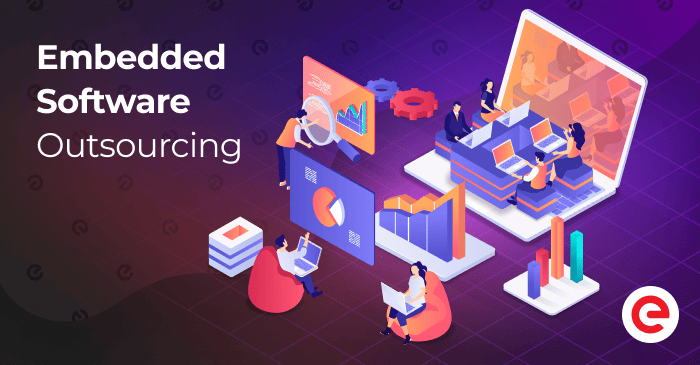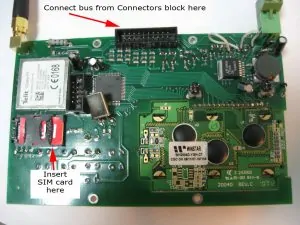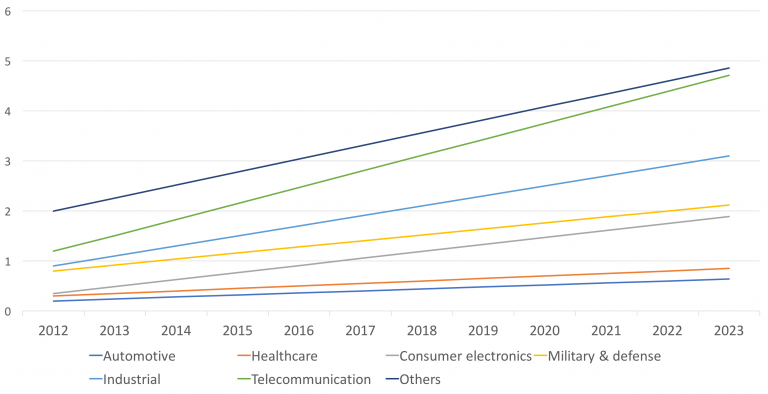
Updated: December 23, 2024
Published: December 10, 2017
Finding a reliable company for outsourcing software development may seem like a challenging task. Search for the company capable of providing embedded software outsourcing services can be even more complicated. Still, after you have found the developers who match your evaluation criteria, 50% of overall success depends on you.
Level of the project management organization, testing process, and knowledge transfer between your in-house staff and outsourced developers are some activities that will require your extensive engagement. In this article, we will explore how to evaluate developers and how to make collaboration with the embedded software development company work.
List of content
- What is embedded software development
- Research methodology
- Experience evaluation
- Technical expertise requirements
- Project management approach
- Conclusion
WHAT IS EMBEDDED SOFTWARE DEVELOPMENT?
Before we proceed to the process of finding the outsourcing company, it’s necessary to clarify what embedded software development is.
This type of development refers to creating software specifically designed to run on embedded systems. Specialized computer systems are embedded within larger devices or products, serving specific functions and often operating in real-time or resource-constrained environments. The software developed for these systems is tailored to meet the unique requirements and constraints of the embedded hardware, enabling it to control, monitor, or enhance the overall system’s functionality.
Embedded software development involves writing code that interacts with the hardware components of the embedded system, such as microcontrollers, sensors, actuators, or communication interfaces. It requires a deep understanding of the hardware architecture, real-time constraints, power consumption limitations, and specific protocols or standards associated with the targeted industry or application.
The goals are to ensure the efficient and reliable operation of the embedded system, optimize performance, meet the desired functionality, and comply with any safety or regulatory requirements. It involves activities such as requirements analysis, system design, coding, testing, integration with hardware, and ongoing maintenance.
That finds implementation in various industries, including automotive, aerospace, consumer electronics, medical devices, industrial automation, and IoT devices. It has a critical role in enabling the desired functionality, performance, and connectivity of these systems and often requires expertise in specific programming languages, development tools, and frameworks tailored to the embedded environment.
HOW TO SEARCH FOR THE EMBEDDED SOFTWARE OUTSOURCING COMPANY
The first challenge you’ll likely meet in your search for embedded outsourcing companies is that major catalogs simply ignore this category. You can’t filter the embedded software outsourcing providers from the huge numbers of development companies represented on Clutch, GoodFirms, etc. It would be much easier to find outsourcing companies that focus on mobile app development or web application development just because they’re listed under those categories. As a result, when you need to find the portfolios/ profiles/ references of embedded software outsourcing companies solely, you have to compose the list manually.
This fact is kind of surprising because according to the Global Market Insights report, the size of this market was valued at 10.46 billion USD in 2015 and is expected to reach at over 7% CAGR from 2016 to 2023.
The growing adoption of electric vehicles will rise dramatically, especially in cargo-carrying, after Tesla announced the first electric-powered truck in 2017. Electric cars, alongside hybrid electric vehicles, will have a significant impact on the embedded software development market over the next years.
Wearable technologies are also showing very promising numbers across many industries, like healthcare, security, safety, IoT, and fitness. The fast-growing demand for advanced embedded software is forecasted.
As you can see, the demand will grow, and hardware companies are going to extend their development resources with the help of experienced embedded software development services as often as never before. In the last couple of years, everybody used to search for providers on B2B reviews and research platforms. However, those listings do not contain company profiles that represent them solely as embedded software outsourcing vendors. Moreover, they discourage outsourcing companies from having such profiles because they don’t match any of the categories. And this makes the research more complicated.
Information about the companies working on embedded software outsourcing can be taken from search engines, referrals, companies’ websites, and unreliable information sources such as forums. All this data is unstructured and requires additional confirmation. We suggest you structure your knowledge about the developers in three key evaluation criteria:
- Previous experience
- Technical skills
- How they manage embedded software outsourcing projects
Let’s talk about them in more detail.
PREVIOUS EXPERIENCE IN EMBEDDED SOFTWARE DEVELOPMENT
As a rule, customers are searching for external embedded software development services for two reasons: first, because of the inability to quickly ramp up their in-house development resources, and second, because they need to get access to the technical capabilities beyond the expertise of the in-house staff. By selecting the embedded software outsourcing company with a rich portfolio, you gain access to the experience in various products and industries that the outsourcing service provider has accumulated during their work in the past. This is considered one of the main outsourcing advantages, which also nicely works for embedded software projects as well.
We can take Existek as an example of a company that provides embedded software outsourcing in multiple domains. Our expertise includes SDK development, firmware development, technical support of third-party solutions, and integration with such solutions. Experience in the development of embedded software projects for the IoT, wearables, and industrial automation may also be considered a nice recommendation.
Embedded outsourcing companies who gained knowledge in various industries and hardware will be able to fuel your product with innovations. For example, the outsourcing company that has previously successfully worked on projects related to wearables is likely to be very good at making any device more power-efficient. They know how to allocate a limited amount of energy by putting the hardware that is not in use in sleep mode, thus minimizing power consumption. This know-how can be a valuable addition for those developing hardware that has to be very efficient in terms of power consumption, like IoT devices. In-house developers or architects who worked all the time with devices that have an unlimited and stable power source, like smart home gadgets, simply weren’t in situations where they have to fight for every extra hour of working from the battery, so they’re likely to less advanced in saving power. Who knows, maybe lower power consumption will become the product’s competitive advantage and the buyers’ decision criteria.
Have difficulty finding developers with the required expertise?
We are a professional software development company providing full-cycle services to address our customers’ needs through extensive expertise in different domains.
TECHNOLOGY EXPERTISE AND TECHNICAL SKILLS EVALUATION
Usually, when you start any offshore outsourcing project service provider gives a bunch of the resumes of the developers who are supposed to be allocated to the project. And these development initiatives are not an exclusion. In this paragraph, we will try to give an exact definition of embedded software developers and how to evaluate their expertise.
Embedded software engineers are a relatively rare breed these days. In retrospect, 20 years ago, the guy who was working on the hardware prototyping was the same developer who wrote low-level code for that hardware. The industry has shifted since then, and large companies have allocated those responsibilities between different roles. However, the survey shows that this old tradition is slowly coming back. For comparison, 20% of embedded systems engineers worked with hardware and software at the same time in 2010, while in 2017, you can expect that nearly 30% of them are working with both. It would be nice if you could find at least one of those specialists on the list of CVs and hire him for your embedded software outsourcing project. They’d definitely be an excellent addition to the dedicated development team.
Obviously, the set of technical skills required from the developer will highly rely on the type of your project and its specifications. Further, we will try to picture the average portrait of the embedded software developer. First of all, they must be experienced in writing code in C and C++. Second, they have to feel comfortable with Embedded Linux and the real-time operating systems (RTOS), which will allow them to work with the limited system resources and, for example, operate CPU usage in the most effective way. These are the essential skills that distinguish the professional developer.
In addition, when the engineers who are working with software exclusively have to know the programming languages, this developer has to have deep knowledge of the hardware and chips. New trendy processor technologies are as essential to know as trendy languages. The processors are the critical component, and the embedded systems and software are built around them.
A qualified embedded software developer should be familiar with control systems, data structures, algorithms, and hardware design language.
Sometimes projects require additional program language knowledge. These languages could be Python, JTAG, or Eclipse.
When you or your in-house team is conducting the interviews with the offshore developers, pay attention to how effectively they can express their thoughts and ideas about the system design graphically. Any developer should be able to explain what’s on their mind using a block diagram, pictures or clouds, or any tools that help to describe the concepts. Especially, this is meaningful in distributed working environments where knowledge transfer between outsourced and in-house developers in both ways is a must.
MANAGEMENT OF THE EMBEDDED SOFTWARE OUTSOURCING PROJECT
Now let’s discuss this question using real embedded software examples.

In 2012 Existek developed software and hardware for the control module of the Carpenter Group water treatment system, which later was installed in many private households in California. The product was released to the market in a straight timeline and budget. Here’s a short description of the product functionality to give you an idea of the project’s complexity. Users are able to monitor and control the water supply remotely via 3G/4G or GPRS on the user web portal. The system is completely automatic, but if needed, the user can see the system status and remotely change settings or start/stop some procedures via the web-based control panel. The device construction also allows the user to tweak it manually if needed, as it includes a control panel with a screen and buttons.
As has been said above, the Carpenter Group water treatment system project has been completed within the planned budget and time. To achieve that, we focused on such aspects as:
The intensive knowledge transfer process
Software and hardware for the control module were developed and prototyped to control a much bigger system with various hardware and equipment manufactured by different vendors. This is a normal way the development process works; thus, it often requires specific skills and manufacturing domain knowledge. Engineers can’t develop the hardware and software for that module without being familiar with all the system components. Required skills cannot be gained by the developers without an extensive knowledge transfer process between the client (manufacturer) and contractor. We managed to set up a knowledge transfer process by direct communication between the customer’s in-house team and offshore developers, including engineering samples transfer and onsite work of the customer’s architects to make sure that our developers are trained to work with the equipment, understand the system design and the global goals of the project. Throwing the documentation over the wall is not working well enough in embedded outsourcing. This is probably the worst possible idea in the context of embedded software outsourcing development. Pay attention to how seriously the provider treats knowledge transfer in this kind of project.
Managing the project closely with smaller tasks
During the negotiations process, we suggested the Carpenter Group a management approach where the entire development process is broken down into smaller tasks. The approach was accepted and, together with extensive knowledge transfer, has brought us remarkable results. The main idea behind this approach is to divide the development process into smaller tasks with very clear objectives and comprehensively described requirements. These tasks typically lasted from five to seven business days. This enabled us to avoid many risks because problems in one task have helped us to see the global issues coming a mile away and prevent them from impacting the rest of the work.

Our project management secured the project from the budget and time overhead. As for the costs, the customer was able to avoid transaction costs overhead which can be relatively high in outsourcing compared to the in-house development (15 to 60 percent and 5 to 10 percent of the contract value, respectively). The project timeline was completed successfully because smaller tasks have mitigated many of the risks related to embedded outsourcing.
CONCLUSION
The last paragraph shows that the way how embedded software development company manages the project defines the success of the collaboration alongside their previous experience and technological expertise. What are your evaluation criteria for choosing the vendor for embedded software projects? Leave your questions and comments below.
Looking for a reliable embedded development company?
Contact Existek, and our team will be in touch in the next 24 hours to discuss your requirements.
Frequently asked questions
Where is the embedded software used?
It's used in a wide range of devices and systems, including automobiles, consumer electronics, medical devices, industrial equipment, aerospace and defense systems, and many other applications.
What are the main aspects to consider when choosing an embedded software developer?
It's worth noting that businesses have to consider the following:
Previous experience
Technical skills
Efficient management
How to choose embedded software outsourcing services?
When choosing embedded software outsourcing services, consider factors such as expertise in the specific industry and technology, track record of successful projects, quality assurance processes, communication and collaboration capabilities, scalability, and cost-effectiveness.
What are useful tips for managing embedded software outsourcing projects?
It always remains important to establish an intensive knowledge transfer process and manage the overall project closely with smaller tasks.

